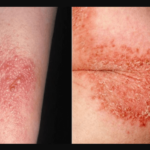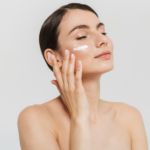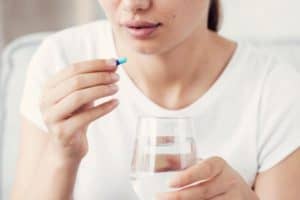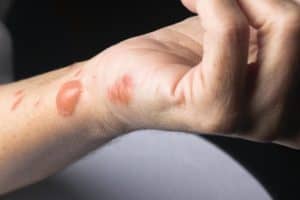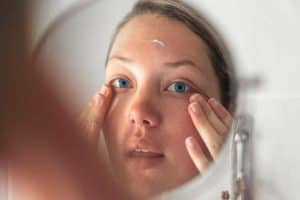I received an email from a client who was asking why her skin was turning black. There are several possible causes, so I decided to make a post on it.
Why is my skin turning black? Your skin may be turning black for several possible reasons:
- Post Inflammatory Erythema / Hyperpigmentation: Dark spots leftover from injury or irritation
- Melasma: Gray-brown patches from sun exposure or hormones
- Freckles: Small brown spots formed from sun exposure, as a result of melanin overproduction
- Sunspots: Similar to freckles but larger and often appearing over age 30
Once you have narrowed down the cause for your skin turning black, there are many treatments you can try to even out your skin tone:
- Hydroquinone (short-term use only)
- Sunscreen
- AHA Solution
- Retinoids
- Vitamin C
- Kojic Acid
- Alpha Arbutin
- Niacinamide and N-Acetyl Glucosamine
Read on to learn more about skin discoloration from hyperpigmentation, including the possible causes and may possible products and treatments.
Also, for an excellent AHA solution, take a look at our top pick, the Nuebiome Glyco-Biotic Ultra Synbiotic Facial:
Click here to see it on Amazon.
Why Is My Skin Turning Black?
1. Hyperpigmentation: What Is It? Causes? Treatments?
Most of these discolorations of the skin can be called hyperpigmentation. Hyperpigmentation is quite common and is often harmless. It simply refers to patches of the skin that become darker in color than the rest of your skin.
This darkening happens when there is an overproduction of melanin. Melanin is a dark brown to black pigment occurring in the hair, skin, and iris of the eye in people and animals. It is what makes the skin tan and go darker.
Pigmentation has definitely been an issue for a lot of individuals. It’s important to identify the different types of pigmentation that we get on our skin so that we can better understand how we can treat them.
I feel like a lot of cosmetic brands like to lump everything into the pigmentation or brightening category. Regardless of whether you have post-inflammatory erythema, post-inflammatory hyperpigmentation, melasma, or sunspots, you will buy their product.
This is a marketing strategy to be aware of so that you don’t buy a product just because it has a label for treating the very common concern of hyperpigmentation.
Next, let’s look at different types of hyperpigmentation — skin turning black or growing darker — so you can better understand why and what is happening to your skin.
Post Inflammatory Erythema / Hyperpigmentation
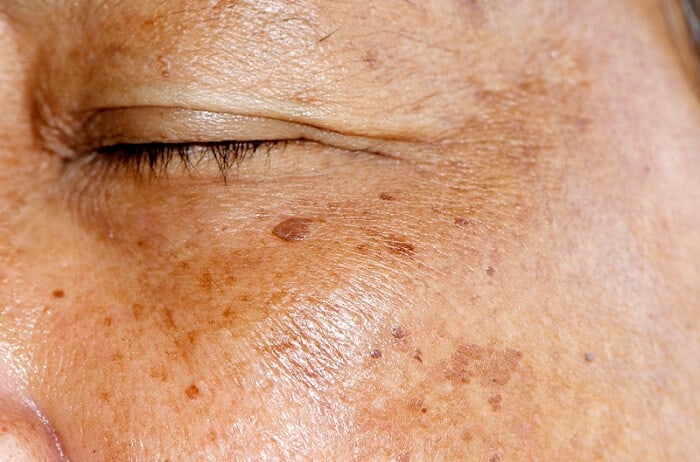
Erythema is defined as superficial reddening of the skin, usually in patches, as a result of injury or irritation causing blood capillaries to grow larger. Post-inflammatory erythema (PIE) refers to the dark red discoloration that is left behind from acne scars, a burn, or a bug bite.
It comes from inflammation and irritation on your skin. It’s more of a vascular issue than excess melanin production hence the redness rather than brown or black.
Treating it is different because it’s about lessening the irritation and inflammation, whereas hyperpigmentation is all about melanin production and inhibiting that.
Post-inflammatory hyperpigmentation (PIH) is similar to PIE in that it comes from an injury or inflammation to the skin, such as acne, psoriasis, a burn, or injury.
But it is more to do with melanin production once the injury is healed and can be more of a brown or black color rather than the irritating redness from PIE.
For a lot of people, particularly if they have a darker skin tone, they already have more melanin in their skin; therefore, acne marks do tend to be hyperpigmentation.
For everyone, those red marks can turn into a brown or even black post-inflammatory hyperpigmentation, particularly if you’re not properly protecting your skin from the sunlight.
Pretty much any type of trauma or inflammation to your skin, whether it’s acne marks, bug bites, or rashes, your skin will respond by producing more melanin in that area to protect it.
Growing up, our parents always told us not to scratch or not to pick but never gave us the reason why. I feel now that our vanity is involved and we are properly incentivized; we are less likely to scratch and pick away.
The good thing about post-inflammatory hyperpigmentation is it is the easiest form to treat. Sunspots and age spots are like localized spots of hyperpigmentation on your skin.
Affected areas are usually our face, chest, and hands, the areas that are always exposed. The lighter ones are obviously easier to treat than the darker ones.
If you already see them appearing, you really want to be diligent about covering that area up and protecting it. Unlike post-inflammatory hyperpigmentation, sunspots actually do require consistent maintenance because they come from the sun, and they come from age.
You can treat them and lighten them significantly, but if you neglect them, then they will come back.
2. Melasma
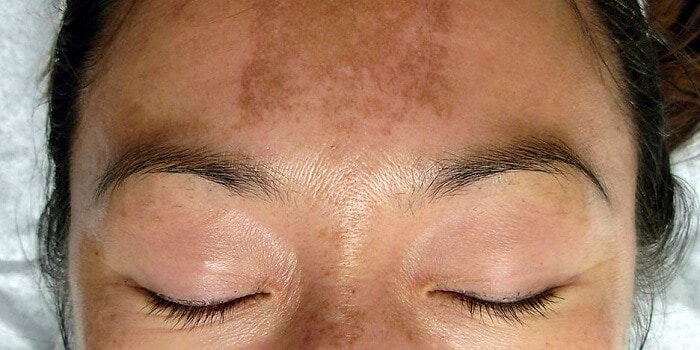
Melasma appears as blotchy patches on your face. In fact, they often have a bit of a matte-like appearance. Usually, it’s around the sides of the face, forehead bridge of the nose, and in the mustache area.
This is usually caused by a combination of sun exposure and a surge of hormones. A lot of times, pregnancy can cause this or starting birth control. This is a harder form of hyperpigmentation to treat. It will take longer to fade, but the worst part is that it can come back very easily.
One of the most common ways to treat melasma is to use sunscreen. So applying an SPF 30 or higher sunscreen each day and reapplying it every few hours.
It is also a good idea to wear long-sleeved shirts and a big hat when outside to protect against further sun exposure and worsening of skin discoloration.
It is more common for women to get melasma than for men. It is very common during pregnancy, so much so that melasma is often referred to as “the mask of pregnancy.”
So other than sun exposure, a big change in hormone production, such as during pregnancy, is a common trigger of melasma.
3. Freckles
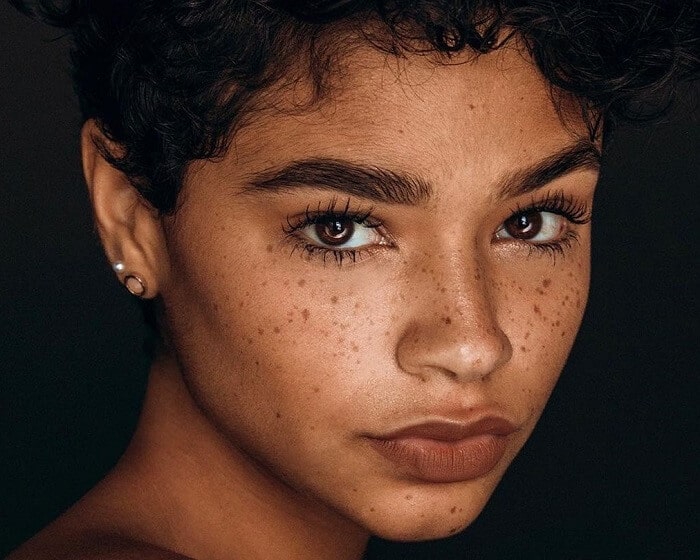
If you’re wondering, “Why is my skin turning black?” freckles may not be the most likely cause; however, if they are grouped together, they could be the answer.
Freckles are also lumped into the hyperpigmentation category. If they group together, they can be mistakenly taken as a dark spot forming. But it is actually just several freckles grouping together.
Some don’t like their freckles but in my personal opinion, if you have freckles, keep them. They’re absolutely charming, and I feel like there’s such a unique feature to have. Removing freckles is going to be entirely different. It actually requires lasers to remove these.
4. Sunspots
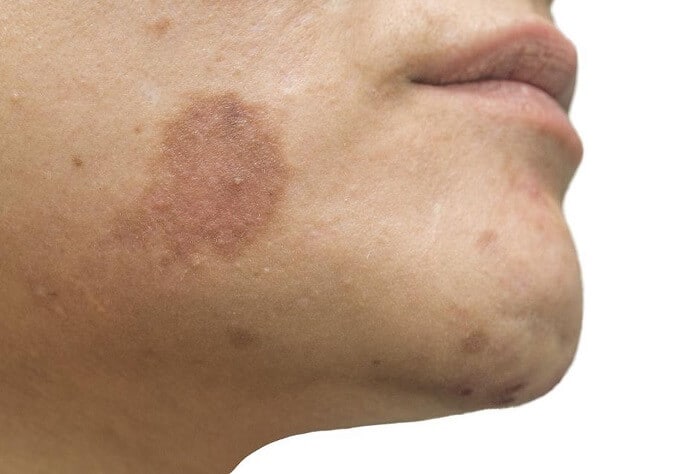
Sunspots are similar to freckles but are normally bigger and darker. As the name suggests, they show up on parts of the skin that is exposed to the sun.
They are also referred to as liver spots, although they have nothing to do with your liver. They form as light brown, dark brown, or black, flat marks on the skin, and are generally harmless.
I have a sunspot that’s been around for a really long time, and actually, for the longest time, it was quite faint and unnoticeable. I did watch it through the years, and it gradually gets darker and darker, even at times where the skin turned black.
For years I experimented with trying different products, and nothing available was even remotely effective despite the huge bold claims from many companies.
Treatments for Hyperpigmentation, Skin Discoloration, Skin Turning Black
There are several products targeted at those with hyperpigmentation. I used hydroquinone with some success but don’t recommend it for long-term use.
1. Hydroquinone: It Is Generally Safe to Use on the Face, but There Are Side Effects
I actually followed the Obagi Nu-Derm System. My dermatologist recommended that I tried that out. After the first week of doing the routine, I felt a little bit like a burn victim, so I just decided to ditch all the other products and just use the hydroquinone on its own twice a day.
Also, instead of putting it over my whole face like it’s recommended, I just used it to spot treat. I would say about four months; it really faded the pigmentation. It faded about 60 to 70%, which is the best I could have hoped for.
I definitely noticed that after a certain point, the continued use of hydroquinone was just not making any more of a difference, so I stopped it immediately. It’s not an ingredient that I want to put on my skin and keep using long-term.
For some, it would work way more effectively than for others, and I have heard stories about how sometimes it actually turns the pigmentation even a little bit grayish. You want to watch out for that.
I do believe, though, that in this present day, there are far more products that are available to us that actually will help treat these issues. But do keep in mind that treating hyperpigmentation does take a lot of consistency and patience.
Now, if you don’t have any patience and you want to get rid of it all much faster, then you can explore laser treatments or professional chemical peels depending on what kind of hyperpigmentation issues you have.
We all don’t have access to those kinds of treatments, so I’ll help you find the products that can really help.
2. Sunscreen
There are different treatments and ingredients that work really well at reducing and fading hyperpigmentation. Sunscreen is a no-brainer; I mean, when we’re talking about hyperpigmentation, it’s all about melanin.
The thing that encourages melanin to be produced in our skin is the sun, so you use an SPF of at least 30 broad-spectrum or with a PA rating with the more pluses, the better. And apply it everywhere, including the hands and legs.
Alpha hydroxy acids are also particularly good at dealing with hyperpigmentation. They really help with sun damage by increasing cell turnover in our skin which in turn will end up fading your dark spots.
3. AHA Solutions
I find that stronger AHA does actually have a really noticeable impact on pigmentation issues such as Drunk Elephant or The Ordinary 30% AHA solutions. Those are once-in-a-week rinse-off masks that I really believe have made a difference.
Click here to see it on Amazon.
Click here to see it on Amazon.
4. Retinoids
Retinoids are also great at reversing sun damage by encouraging cell turnover. But when you are using retinoids and AHAs, you need to be super careful to make sure you are wearing sunscreen because it will make your skin that much more sensitive.
5. Vitamin C
Vitamin C is not only so important for protecting your skin against the sun, but it’s also great at fading sunspots and reversing sun damage in your skin.
But for that, you really need to use ascorbic acid, about 20%, alongside all these other melanin inhibitors or other treatments like AHAs or retinol just to ensure that it keeps that pigment at bay.
If you have the kind of hyperpigmentation that keeps coming back and reoccurring, like melasma and sunspots, you want to make sure that your skin is armed as well as possible against the sun’s rays.
6. Kojic Acid
These next few ingredients are the ones that we know to be the brightening ones. They reduce hyperpigmentation by inhibiting an enzyme called tyrosinase which is responsible for the formation of melanin. These are all melanin inhibitors.
Kojic acid has been known as an alternative to hydroquinone. I feel like this is one of the more effective ingredients that can noticeably brighten the skin and fade marks. This is the main ingredient in a lot of dark-spot correcting products.
What I love about this ingredient is that kojic acid is produced through the sake brewing process of fermented rice.
7. Alpha Arbutin
Alpha Arbutin is another alternative to hydroquinone. This is an ingredient that’s used in a lot of Asian whitening products. I also want to mention that Ordinary’s 2% Alpha Arbutin Solution actually did work for me.
Click here to see it on Amazon.
It definitely took a while of consistent use, but around the third month, I began to notice there was a breaking up of pigment in my affected spot. I used it every day as a spot treatment, and I feel that, in conjunction with a good vitamin C serum, really made all the difference.
8. Niacinamide and N-Acetyl Glucosamine
Niacinamide is something that I felt worked really well for my post-acne redness. It also works well as a melanin inhibitor, especially when you’re talking about a concentration of about 4% or more.
But where it really works more effectively at fading and minimizing hyperpigmentation is when it’s combined with another ingredient called N-acetyl glucosamine.
This is also a melanin inhibitor, but it’s been found that both these ingredients work better together in dealing with hyperpigmentation.
Click here to see it on Amazon.
You’ll find this combination in many whitening or brightening ingredients, as well as a lot of BB and CC creams. Licorice root extract is another ingredient that you’ll find in so many Asian products.
It is present in almost every product that I know, and it’s somewhere there on the ingredients list. This is also a melanin inhibitor that’s great for brightening up the skin.
From the least to the most difficult to get rid of, let’s talk about the different forms of hyperpigmentation and the best ways to treat them. All the melanin inhibitors that were mentioned will help hyperpigmentation no matter what form it comes in.
Post-inflammatory hyperpigmentation can be effectively treated with some good acids and a great vitamin C serum. You don’t actually need retinol to get rid of this.
When you talk about age and sun spots, retinoids can really make a difference, alongside all the other treatments that can help inhibit melanin production. Do remember that even after it successfully fades, it can come back if you neglect it.
Melasma is probably the most resistant form of hyperpigmentation – it takes very little for it to just keep coming back in for it to get darker. You have to be so conscientious about treating it.
Chemical aging treatments are particularly good at treating melasma. A good vitamin C and retinoid product will help treat melasma.
Conclusion – Why Is My Skin Turning Black?
To recap, why is my skin turning black? Your skin may be turning black for several possible reasons:
- Post Inflammatory Erythema or Hyperpigmentation: Dark spots from injury or irritation
- Melasma: Gray-brown patches from hormones or sun exposure
- Freckles: Small brown spots formed from sun exposure
- Sunspots: Similar to freckles but larger
It is quite normal for many people to darken by a shade or two while they are a teen or in their early 20s. Yet, a significant number of them recover a portion of their shading as they get settled in progressively ‘indoor’ occupations. The shade our skin takes on relies a lot on exposure to the sun or pollution.
If your skin discoloration is not caused by being outdoors with exposure to the sun, then there might be different reasons for pigmentation, as part of hormonal changes, vitamin deficiencies, or genetics.
The pattern of how your skin has becoming darker or turning black can be assessed by a dermatologist. This progression can give the dermatologist knowledge into the reason for your pigmentation.
The following tips can be used to clear dark spots and brighten your skin: Use sunscreen every day. Ensure to use an SPF 30 and apply it half an hour before going outside.
Also applying a moisturizer before bed to keep your skin hydrated and prevent it from drying out and breaking down. Another solution can be peeling agents and skin brightening treatments prescribed by a dermatologist to even out uneven skin tones.







![Neutral Skin Tone Defined [and Best Colors for Neutral Skin] neutral skin tone](https://skincaregeeks.com/wp-content/uploads/2021/05/neutral-skin-tone-150x150.png)

